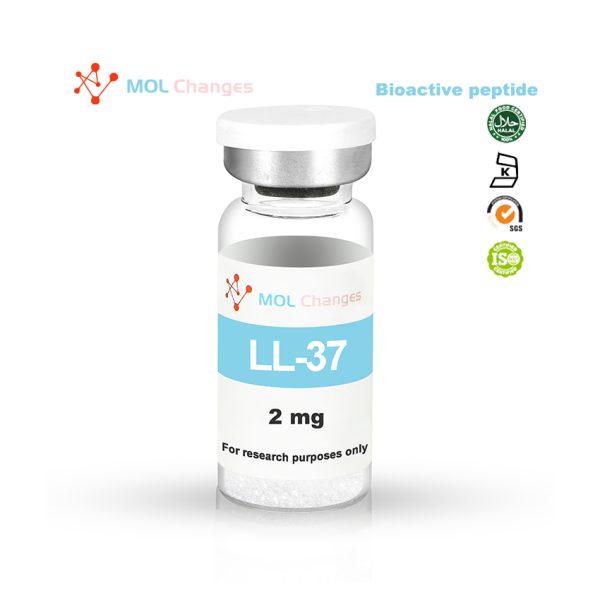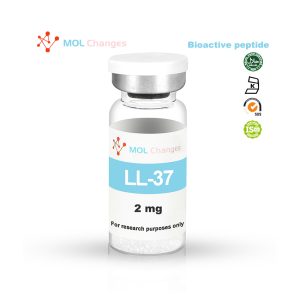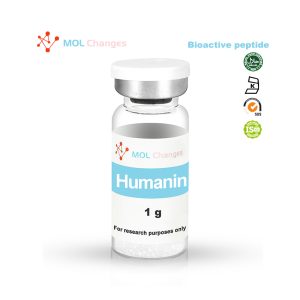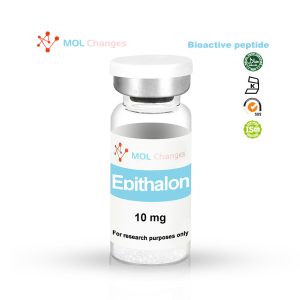LL-37 is the only known human cathelicidin, which is a large family of proteins with multiple functions. These peptides are found primarily in macrophages and polymorphonuclear leukocytes (two types of white blood cells) and are important for killing bacteria, but they have also been found to have other significant roles. The entire class is commonly referred to as antimicrobial peptides (AMPs).LL-37 has been found to play important roles in autoimmune diseases, cancer, and wound healing.
Sequence
Leu-Leu-Gly-Asp-Phe-Phe-Arg-Lys-Ser-Lys-Glu-Lys-Ile-Gly-Lys-Glu-Phe-Lys-Arg-Ile-Val-Gln-Arg-Ile-Lys-Asp-Phe-Leu-Arg-Asn-Leu-Val-Pro-Arg-Thr-Glu-Ser
CAS Number
154947-66-7
Molecular Formula
C205H340N60O53
Molecular Weight
4493.342
LL-37 Related research
LL-37 is an effective antimicrobial agent
LL-37 is part of the innate immune system and is therefore one of the first to be activated during infection. Studies of skin infections have shown that normal skin levels of LL-37 are very low, but the peptide accumulates rapidly in the presence of invading pathogens. This peptide has been shown to work synergistically with other proteins (e.g., human β-defensin 2) to fight infection.
LL-37 acts primarily by binding to bacterial lipopolysaccharide (LPS), which is a major component of the outer membrane of Gram-negative bacteria.LPS is a key component of the membrane integrity of these bacteria.LL-37’s ability to bind to and interfere with LPS means that it is extremely lethal to some bacteria. There is interest in using exogenous peptides to treat severe bacterial infections in humans.
Although LL-37 acts on the cell membrane components of Gram-negative bacteria, it is still effective against Gram-positive bacteria. This may make it a useful treatment for staphylococcal infections and other serious bacteria. In vitro studies have shown that LL-37 enhances the action of lysozyme, an enzyme responsible for destroying Gram-positive bacteria such as Staphylococcus aureus.
LL-37 and Lung Disease
As mentioned above, LPS is not unique to bacterial cell walls. It is found in many different organisms and in some cases is airborne when the environment is contaminated with molds or other fungi. When LPS is inhaled, normal lung tissue responds. Unfortunately, this response is often insufficient to prevent toxic dust syndrome and the pathogenesis of respiratory diseases such as asthma and COPD. The use of LL-37 as an inhalation treatment for toxic dust syndrome is currently being investigated.
An interesting finding from studies of the effects of LL-37 on lung disease is that the peptide promotes epithelial cell proliferation and wound closure.One of the main properties of LL-37 (at least in the lungs) appears to be the attraction of airway epithelial cells to the site of injury, facilitating wound healing and growth of blood vessels needed to provide nutrients to the new tissues.LL-37 appears to be an important homeostatic modulator in the airways, just as it has been found to be a homeostatic regulator of immune function, just as it has been found to be a homeostatic regulator of immune function.
Understanding the role of LL-37 in arthritis
Studies in rats have shown high concentrations of LL-37 in joints affected by rheumatoid arthritis. In particular, the peptide appears to be associated with pathological events in arthritis. However, it is not clear whether this peptide is a pathogenic factor or whether its upregulation in these joints is part of the body’s attempt to control the pathologic process.Nevertheless, there are several things that suggest that LL-37 is beneficial to inflammation rather than a pathogenic factor.
First, there is no evidence that LL-37 or any other antimicrobial peptide is involved in the pathogenesis of inflammatory diseases. This does not rule out the peptide as a pathogenic factor, but the evidence is very much against this. In particular, LL-37 deficiency does not affect outcomes in animal models of arthritis or lupus. In other words, animals without LL-37 experience the same pathologic progression as those with the peptide. Based on these findings, the scientists propose that the response to antimicrobials in arthritis may be the result of widespread overexpression of the peptide in inflamed tissues, in other words, it’s coincidental.
Studies on mouse models of arthritis have shown that peptides derived from LL-37 prevent the collagen damage that often occurs in inflammatory arthritis. On the basis of this study, it is reasonable to hypothesize that LL-37 may have protective activity against arthritis, which could explain its high concentration in severely inflamed tissues, since direct administration of these peptides to affected joints reduces the severity of the disease as well as serum levels of anti-type II collagen antibodies. This hypothesis is supported by the fact that LL-37 and its derivatives have been shown to modulate inflammation induced by interleukin 32, a molecule that is directly related to the severity of inflammatory arthritis.
Arthritis is also associated with the upregulation of Toll-like receptor 3 in synovial fluid fibroblasts, a factor that may exacerbate arthritis by increasing the levels of inflammatory cytokines.LL-37 has been shown to bind to TLR4 and promote either pro- or anti-inflammatory effects. Its role in the context of TLR3 upregulation is unknown, but research is ongoing. Given that LL-37 has been found to selectively reduce pro-inflammatory macrophage responses in the past, the idea that it may selectively reduce inflammation is not unreasonable.
LL-37 and intestinal
Cell culture studies have shown that LL-37 has multiple effects on the gut. First, the peptide increases cell migration required to maintain the intestinal epithelial barrier. Second, LL-37 reduces apoptosis in intestinal inflammation, helping to slow the pathogenesis of several inflammatory conditions. Overall, this study suggests that LL-37 may be an effective adjunctive therapy for inflammatory bowel disease, after intestinal surgery, or for acute intestinal infections. It may even prove useful as an adjunct to antibiotic therapy, helping to prevent gastrointestinal side effects that typically limit the use of oral antibiotics.
LL-37 does not work alone in the gut; it will again pair with human β-defensin 2 to promote wound healing. Cell culture studies have shown that these peptides work synergistically to repair and maintain the intestinal epithelium while reducing TNF-related cell death. Currently, TNF-α inhibitors are the mainstay of treatment for inflammatory bowel disease. They are effective drugs but have many serious side effects, including leading to a dramatically increased risk of serious infections such as tuberculosis. The development of LL-37-based treatments for inflammatory bowel disease may help to reduce reliance on TNF-α inhibitors and improve morbidity and mortality in this patient group.
LL-37 and Bowel Cancer
Studies on LL-37 and cancer have produced mixed results, but the peptide appears to be beneficial in bowel and gastric cancers, including oral squamous cell carcinoma associated with smoking and tobacco use. Interestingly, these effects appear to be mediated by the vitamin D-dependent pathway, which may explain why taking the vitamin before is associated with a reduced risk of gastrointestinal cancers. Vitamin D appears to induce anticancer activity in tumor-associated macrophages via LL-37.
LL-37 and blood vessel growth
LL-37 appears to trigger the synthesis of prostaglandin E2 (PGE2) in endothelial cells.PGE2 is associated with inflammatory pain and vascular growth, but these effects vary depending on where the molecule is expressed. In endothelial cells, PGE2 triggers blood vessel development in a process called angiogenesis, which can be good or bad depending on the specific setting. The ability to regulate angiogenesis has been the focus of much research over the past few decades, as it affects cancer development, heart disease, stroke outcomes, wound healing, etc. LL-37 activity provides a useful approach to exploring angiogenic pathways, and a model for potential future interventions to promote blood vessel growth when needed (e.g., heart disease) and to inhibit blood vessel growth when it is harmful ( e.g. cancer).
COA
HPLC
MS
Article/Literature Citation Notes
The purpose of quoting the scientist and professor's article is to acknowledge, recognise and applaud the exhaustive development work that has been done to undertake this peptide research. The scientist does not in any way support or advocate the purchase, sale or use of this product for any reason, and MOL Changes has no affiliation or relationship, implied or otherwise, with the scientist.
- J. M. Kahlenberg and M. J. Kaplan, “Little peptide, big effects: the role of LL-37 in inflammation and autoimmune disease,” J. Immunol. Baltim. Md 1950, vol. 191, no. 10, Nov. 2013.
- D. S. Alexandre-Ramos et al., “LL-37 treatment on human peripheral blood mononuclear cells modulates immune response and promotes regulatory T-cells generation,” Biomed. Pharmacother. Biomedecine Pharmacother., vol. 108, pp. 1584–1590, Dec. 2018.
- P. Y. Ong et al., “Endogenous antimicrobial peptides and skin infections in atopic dermatitis,” N. Engl. J. Med., vol. 347, no. 15, pp. 1151–1160, Oct. 2002.
- C. D. Ciornei, T. Sigurdardóttir, A. Schmidtchen, and M. Bodelsson, “Antimicrobial and chemoattractant activity, lipopolysaccharide neutralization, cytotoxicity, and inhibition by serum of analogs of human cathelicidin LL-37,” Antimicrob. Agents Chemother., vol. 49, no. 7, pp. 2845–2850, Jul. 2005.
- X. Chen et al., “Synergistic effect of antibacterial agents human β-defensins, cathelicidin LL-37 and lysozyme against Staphylococcus aureus and Escherichia coli,” J. Dermatol. Sci., vol. 40, no. 2, pp. 123–132, Nov. 2005.
- M. Golec, “Cathelicidin LL-37: LPS-neutralizing, pleiotropic peptide,” Ann. Agric. Environ. Med. AAEM, vol. 14, no. 1, pp. 1–4, 2007.
- R. Shaykhiev et al., “Human endogenous antibiotic LL-37 stimulates airway epithelial cell proliferation and wound closure,” Am. J. Physiol. Lung Cell. Mol. Physiol., vol. 789, no. 5, pp. L842-848, Nov. 2005.
- M. H. Hoffmann et al., “The cathelicidins LL-37 and rCRAMP are associated with pathogenic events of arthritis in humans and rats,” Ann. Rheum. Dis., vol. 72, no. 7, pp. 1239–1248, Jul. 2013.
- D. Kienhöfer et al., “No evidence of pathogenic involvement of cathelicidins in patient cohorts and mouse models of lupus and arthritis,” PloS One, vol. 9, no. 12, p. e115474, 2014.
- L. N. Y. Chow et al., “Human cathelicidin LL-37-derived peptide IG-19 confers protection in a murine model of collagen-induced arthritis,” Mol. Immunol., vol. 57, no. 2, pp. 86–92, Feb. 2014.
- K.-Y. G. Choi, S. Napper, and N. Mookherjee, “Human cathelicidin LL-37 and its derivative IG-19 regulate interleukin-32-induced inflammation,” Immunology, vol. 143, no. 1, pp. 68–80, Sep. 2014.
- W. Zhu et al., “Arthritis is associated with T-cell-induced upregulation of Toll-like receptor 3 on synovial fibroblasts,” Arthritis Res. Ther., vol. 13, no. 3, p. R103, Jun. 2011.
- K. L. Brown et al., “Host defense peptide LL-37 selectively reduces proinflammatory macrophage responses,” J. Immunol. Baltim. Md 1950, vol. 186, no. 9, pp. 5497–5505, May 2011.
- J.-M. Otte et al., “Effects of the cathelicidin LL-37 on intestinal epithelial barrier integrity,” Regul. Pept., vol. 156, no. 1–3, pp. 104–117, Aug. 2009.
- J.-M. Otte et al., “Human beta defensin 2 promotes intestinal wound healing in vitro,” J. Cell. Biochem., vol. 104, no. 6, pp. 2286–2297, Aug. 2008.
- X. Chen et al., “Roles and Mechanisms of Human Cathelicidin LL-37 in Cancer,” Cell. Physiol. Biochem. Int. J. Exp. Cell. Physiol. Biochem. Pharmacol., vol. 47, no. 3, pp. 1060–1073, 2018.
- Salvado M. Dolores, Di Gennaro Antonio, Lindbom Lennart, Agerberth Birgitta, and Haeggström Jesper Z., “Cathelicidin LL-37 Induces Angiogenesis via PGE2–EP3 Signaling in Endothelial Cells, In Vivo Inhibition by Aspirin,” Arterioscler. Thromb. Vasc. Biol., vol. 33, no. 8, pp. 1965–1972, Aug. 2013.
- D. Xhindoli, S. Pacor, M. Benincasa, M. Scocchi, R. Gennaro, and A. Tossi, “The human cathelicidin LL-37 — A pore-forming antibacterial peptide and host-cell modulator,” Biochim. Biophys. Acta BBA – Biomembr., vol. 1858, no. 3, pp. 546–566, Mar. 2016.
warning
These products are intended for scientific purposes only for in vitro research and are not to be used for human, animal or unethical experiments, in vitro research (Latin: in glass) is conducted in vitro. These products are not drugs and are not approved by the Food and Drug Administration in any country for the prevention, treatment or cure of any medical condition, disease or illness. The introduction of this product into humans or animals in any form is strictly prohibited by law.






